Text
Evolution of the Larothan Ribbon Belt (lore beneath the cut)

So, this starts with the local currency of Laroth (Laroth is not a single country, and does not have a unified currency, but that’s for another post- I’ll just treat it as such here) which originally consisted of Chinese-style silver coins with holes in the middle. These holes meant that you could string them up on a piece of cord and carry large amounts of them easily that way. (This also served as a standardised unit, but again that’s for a future post about currency.)
People start wearing these strings on their belts, since pockets aren’t really a thing yet. Rich people, to show off, start wearing large amounts of them, all around their waists. Not only does this show off that they have that much money, it also shows that they can walk around in public with that much money without worrying about thieves and robbers, whether that is because they can afford to hire bodyguards or for some other reason. This still isn’t enough flaunting for some though, so they start using fancier materials, replacing the plain cord with gold/silver chains, or intricately patterned ribbons.
This currency stays around for a fairly long amount of time (how long exactly I haven’t decided yet) and this trend becomes pretty well-established in Larothan culture as a way for the rich to show off. It starts seeping into the fashion of the lower classes as well, as a set of plain ribbons or tassels attached to the belt.
Eventually, Laroth switches to coins without holes in them (again, Laroth has multiple currencies and not all of them did) and people started carrying their money in pockets (the medieval kind not the modern kind), purses, wallets, etc. The ribbons now end up entirely useless for carrying money, but by this point they’ve been a part of Larothan fashion for a long time and so they stick around, except since they can’t carry money it becomes entirely about the ribbons themselves.
Since they no longer have to serve a practical purpose, these evolve into many styles. Some are plain, just dyed with more expensive dyes (reds, blues, greens, purples). These are mostly worn by peasants and such. Then they get fancier with patterns and tassels and so on. Some incorporate bits of gold, silver, lumin, and other precious materials. Some have beads or glass or other decoration. Some have elements evoking the coins they once held, while others completely ignore the history of the garment and are made in ways that could never hold a coin.
They differ massively based on class, and there are many regional variants- especially since some areas did not move away from the old style of coins with holes, so they still serve their original coin-holding purpose there.
9 notes
·
View notes
Text
Bluelake is one of the largest and richest cities in the desert of Laroth. It owes its success to its location- specifically there are 3 factors that led to it becoming an influential trade hub.
Firstly, Bluelake is built around an oasis, as its name would suggest. This provides it with a near-unlimited supply of freshwater, which is crucial in the desert. Almost all major settlements in Laroth are built around oases, as without an oasis it's almost impossible to obtain enough water to sustain a large population.
Secondly, Bluelake lies along an Iron Road. The Iron Roads are the remains of the extensive railway network of the Old Empire. After the Old Empire's fall, the knowledge to build or maintain trains was lost, but the Iron Roads are still important for trade- they act as a navigation aid, and the bridges and tunnels that still remain make travel much easier. As such, Bluelake's location along one of these roads meant that lots of travelers would pass through its location.
Finally, Bluelake is also located right at the mouth of the Placeholdername Gap, a large gap in the mountain range that forms the eastern edge of the desert. This is the only spot for over a hundred kilometers either way where travel across the mountains is possible, thus giving Bluelake almost complete control over trade between the two sides.
Bluelake started off as just another rest stop along the Iron Road, but quickly grew because of all these factors until it became the (relative to the other Larothan city-states) superpower it is now.
Think of a major settlement in your world. How did people come to live there specifically?
126 notes
·
View notes
Text
Part Of My World's Magic System
Previous Post First Post
Originally posted to r/worldbuilding, I'm moving my stuff to Tumblr because of the recent Reddit shenanigans. Note, this comic was made purely to flesh out the world, so there's no real story or characters.



There are four ingredients in Alori magic: Dust, like with every other kind of magic; a spellbook, though that is not necessary for all spells; a spell scroll, while a scroll is traditional, spells can be written on anything; and a key, though some spells have them built-in. To cast a spell, you must hold the spell scroll in your right hand, attatch your Key, then speak the Casting Incantation, a short phrase in the Ancient Speech. After speaking the Incantation, a small amount of Dust flies onto the scroll, travelling across it from top to bottom and reading the Commands. This can take anywhere from less than a second to more than ten minutes depending on the length of the spell. Once it's complete the rest of your Dust joins them in carrying out the spell.
While some basic spells do not require a spellbook, you need one to do anything more complicated than Commanding your Dust to move in a cardinal direction. Spellbooks contain a different kind of spell which other spells can rely on to carry out more difficult tasks. However for a spell to access the spells in the spellbook the key needs to be modified to guide the Dust to the spellbook, where it will read that as well. Because every spellbook is unique, each person's Key needs to be custom as well.
The Fall of Humanity left many artefacts behind. Once of the most influential (on Eren B at least) are the vast amount of nanites spread across it's surface. In the hundreds of years since several different civilizations have rediscovered methods to control them, though none so far have managed to use them to their full extent. The Alori were able to figure out some fragments of Python through sheer trial and error, since their religon forbids them from plundering ancient sites. Other cultures who did not have such reservations were later able to expand upon this knowledge, discovering several modules in the wreck of HMS Lexington which they have since transcribed many times.
Eren B is a tidally locked moon. After Humanity Fell the survivors have rebuilt civilization to a medieval-ish level of technology. This comic takes place in Laroth, a large desert near the equator.
The original post on Reddit didn't get much attention, so there aren't any useful comments to copy over here.
#worldbuilding#world building#conworld#fantasy#fantasy worldbuilding#post apocalyptic#post post apocalypse#fantasy art#original world#comic#mini comic#reddit#reddit migration
5 notes
·
View notes
Text
I 3D printed some coins from my world
Originally posted to r/worldbuilding, I'm moving my stuff to Tumblr because of the recent Reddit shenanigans.
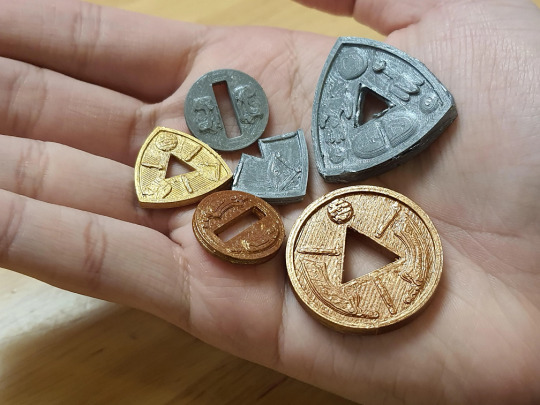
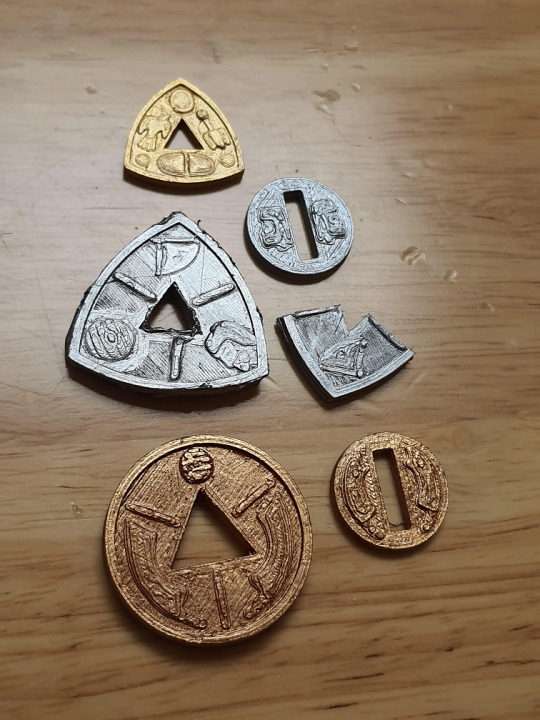
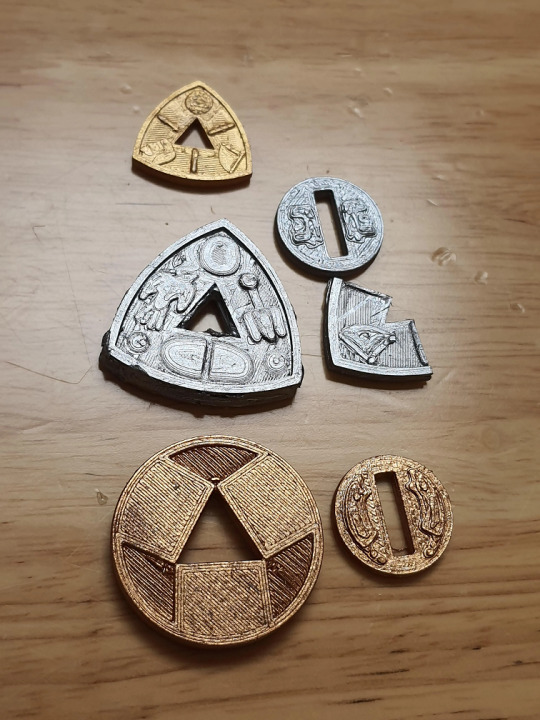

These coins are from Bluelake, the largest city-state in the desert of Laroth. The silver ones are called senn, the gold ones glen and the copper ones fen. The smaller silver and copper coins are called valsenn and valfen.
1 gold coin is worth 10 silver, 1 silver is worth 10 copper and the smaller variants are each worth 1/4 of the larger coin.
The senn that's been cut into 3 is called an arrowhead because of the shape and is worth 1/3 senn.
They are cast then sanded down like ancient Chinese coins, and that is why they have a hole in the middle, so they can be put on a rod and rotated to sand them down (the triangular ones are reuloux triangles so it works for them too).
#worldbuilding#world building#conworld#fantasy#fantasy worldbuilding#post apocalyptic#post post apocalypse#fantasy art#original world#reddit#reddit migration#3d printing
164 notes
·
View notes
Text
Originally posted to r/worldbuilding, I'm moving my stuff to Tumblr because of the recent Reddit shenanigans. Note, this comic was made purely to flesh out the world, so there's no real story or characters.
Previous Post First Post Next Post

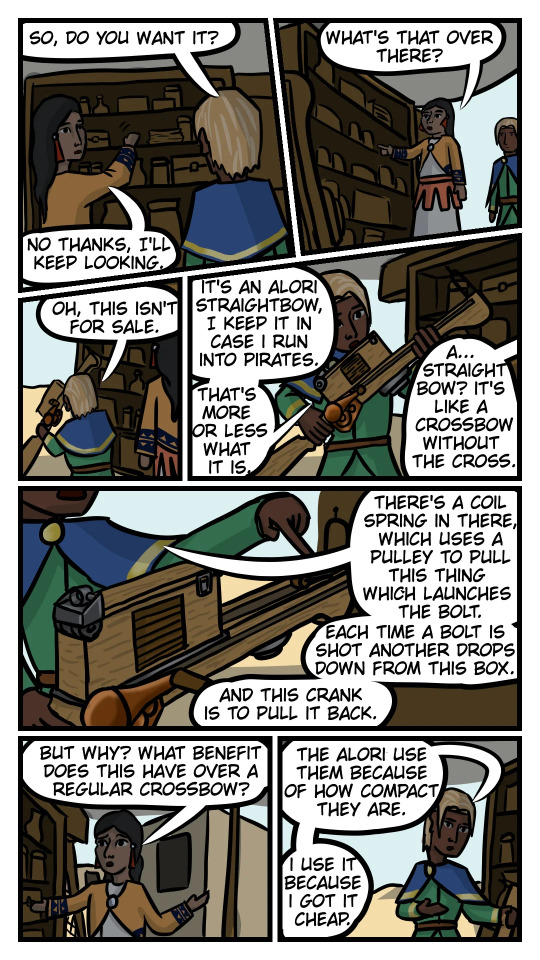
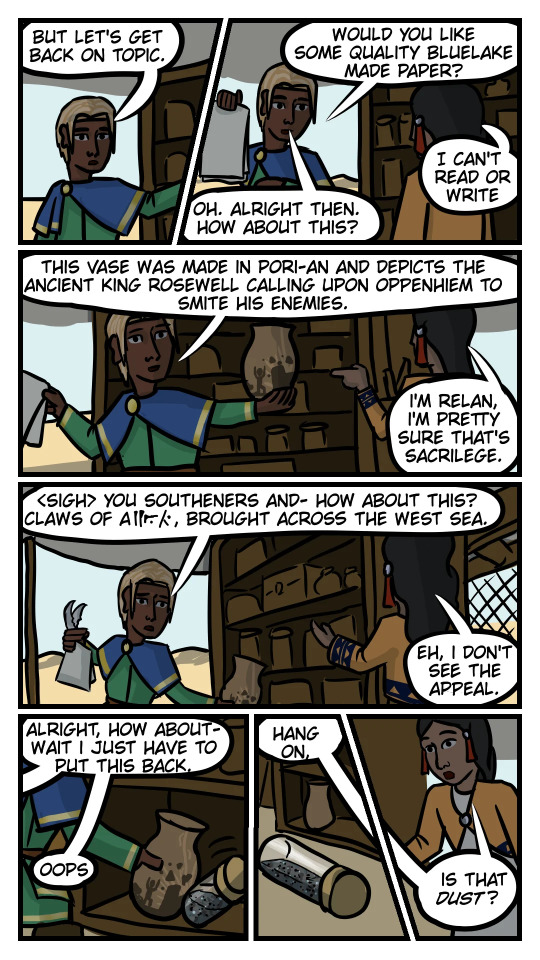
And some of the comments on the original post:

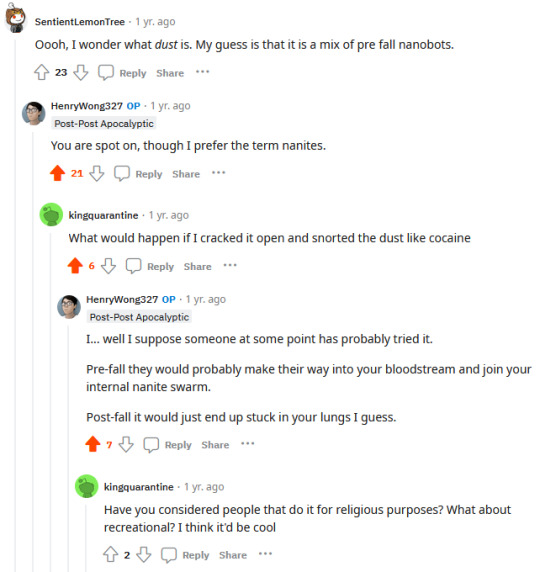


#worldbuilding#world building#conworld#fantasy#fantasy worldbuilding#post apocalyptic#post post apocalypse#fantasy art#original world#comic#mini comic#reddit#reddit migration
1 note
·
View note
Text
Coins of Bluelake and Larothan Herbs
Previous Post First Post Next Post
Originally posted to r/worldbuilding, I'm moving my stuff to Tumblr because of the recent Reddit shenanigans. Note, this comic was made purely to flesh out the world, so there's no real story or characters.
This was also originally 2 posts on Reddit. The first page was in the first post, and the last 3 pages in the 2nd.




I think I'll actually change the coinage system into a purely silver-based system. I chose gold silver and copper back then because I wanted to use this world for D&D, but now I've realised that it's too different from the Forgotten Realms to be compatible with D&D (or Pathfinder 2E)'s ruleset.
The triangular coins are reuleaux triangles, a really interesting kind of "triangle" with curved sides that can roll. The coins are cast, which is why they can have that hole in the middle.
The original posts on Reddit didn't get much attention, so there aren't any useful comments to copy over here.
#worldbuilding#world building#conworld#fantasy#fantasy worldbuilding#post apocalyptic#post post apocalypse#fantasy art#original world#comic#mini comic#reddit#reddit migration
1 note
·
View note
Text
Sandships
Previous Post First Post Next Post
Originally posted to r/worldbuilding, I'm moving my stuff to Tumblr because of the recent Reddit shenanigans. Note, this comic was made purely to flesh out the world, so there's no real story or characters.
This was originally 2 posts on Reddit. The first 2 pages were in the first post, and the last 3 pages in the 2nd. I made the 2nd post as a retcon because people in the first post pointed out tons of issues with using wax.
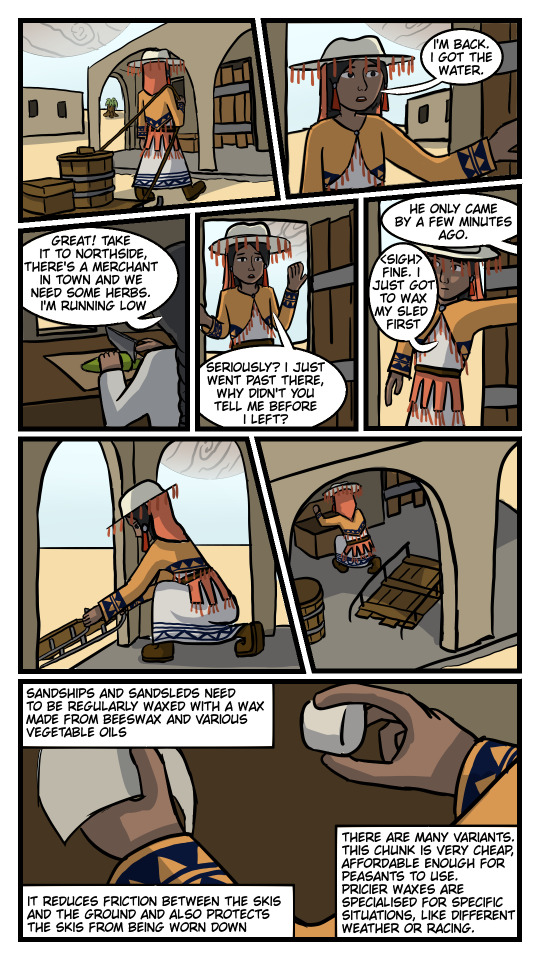


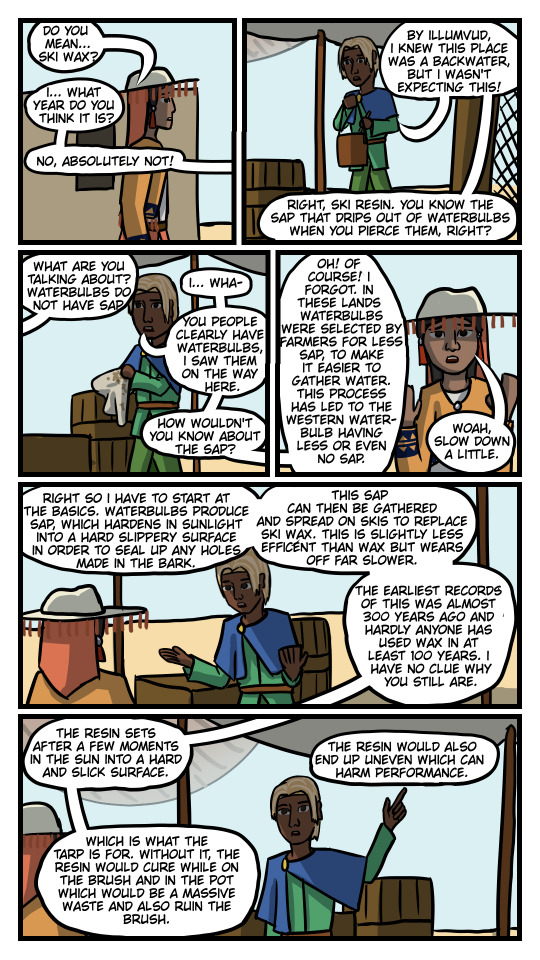

Sandships and sandsleds must have their skis coated with resin to reduce friction and protect them from being worn down. This resin is gathered from waterbulbs, a large bulbous "tree" that collects during the rainy season then stores it in a cavity for the rest of the year. Many animals have adapted to break through the bark to get at the water inside so they have developed a sap that is held inside the bark, which seeps out when it's damaged, hardens in the sunlight and covers up the hole. This resin happens to be very slippery, so it was used by Larothans to replace the earlier wax that was used to coat sandsled skis. This new lubricant allowed sandsleds to get bigger eventually resulting in sandships.
I originally planned for them to use wax like modern-day sandskiiers/ sandboarders/ sandsleders, but when I posted that on reddit I was informed that those waxes wear off extremely quickly and have to be reapplied after every ride, so I ended up changing it to a resin from a fictional plant thus circumventing the realism issue.
The bit about waterbulbs in different regions being bred for less resin originally started as just a way to justify why this wasn't brought up in the earlier pages but I actually quite like the idea and might expand on it more.
Thanks to u/Astro_Alphard for helping me with this idea.
**Replies to useful comments on the original post: **(paraphrased)
Is the sand magical in some way to make it easier?
No, that doesn't fit my world's magic system, but someone else mentioned that extremely fine-grained sand would reduce friction, and increase the number of dust storms (which is something I want), so that's canon now.
Where does the wood to build ships come from?
Trees live near most oases, some wood is imported from wetter places, and there are a few species, such as the waterbulb, that have adapted to live in the deep desert.
#worldbuilding#world building#conworld#fantasy#post apocalyptic#post post apocalypse#fantasy art#fantasy worldbuilding#original world#comics#mini comic
1 note
·
View note
Text
Tapping A Waterbulb
Next Post
Originally posted to r/worldbuilding, I'm moving my stuff to Tumblr because of the recent Reddit shenanigans. Note, this comic was made purely to flesh out the world, so there's no real story or characters.
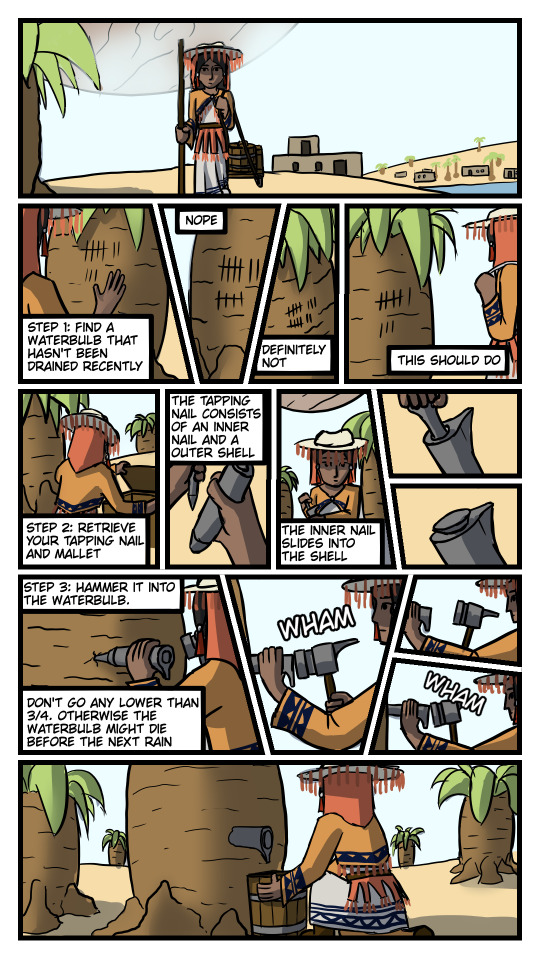

Waterbulbs are a hollow plant that live in the desert of Laroth. They are used by the people who live there as a source of water and sometimes for wood, though the latter is less common since waterbulb wood is rather weak.
Other than the tapping nail shown in the comic, some people also use a modified auger to tap waterbulbs. This method is slightly more time-consuming but they wear out much more slowly and also damage the waterbulb less.
A typical waterbulb can be used to fill 6-10 buckets before running out. You then have to leave it for a few dozen days before it refills.
Replies to useful comments on the original post: (paraphrased)
What is done with the nail afterwards?
After the waterbulb runs out, the nail is yanked out (and the lip on the bottom lets you lever it out with a hammer) and the hole is plugged with clay. The nail is reused and most people would only have 1 or 2.
What's with the tallies, they don't make sense?
I didn't put much thought into the tallies, I've decided since then that they carve the date into the clay plugs. Then the next time the waterbulb is drained they hammer the nail into the plug, thus wiping out the old marks.
This seems more practical in a farming situation, instead of searching for them in the wild.
This is a sort of farm. These waterbulbs shown here are domesticated, wild ones are smaller, contain less water, and are often poisonous.
How do they get water in the desert?
Rain. The reason why they store water is to last them until the next rain, which may take months.
What inspired this?
Coconuts and Maple Syrup.
#worldbuilding#world building#conworld#fantasy#post apocalyptic#post post apocalypse#fantasy worldbuilding#original world#reddit migration#reddit#fantasy art#mini comic#comics#nuclear spring
6 notes
·
View notes
Text
It depends on the region, but generally no.
While the Fall of humanity resulted in most technological advancement being lost, the social attitudes of the pre-apocalypse human civilization remained (barring a few exceptions, such as racism being reinvented by several warlords to justify their invasions).
This includes how they see adopted children. As such there are generally very few differences. However, in a few places, if the adopted child does not know their biological lineage, they may have trouble getting married because they cannot prove they are not related to their spouse.
Are there any legal differences between biological and adopted children in your setting?
169 notes
·
View notes
Text
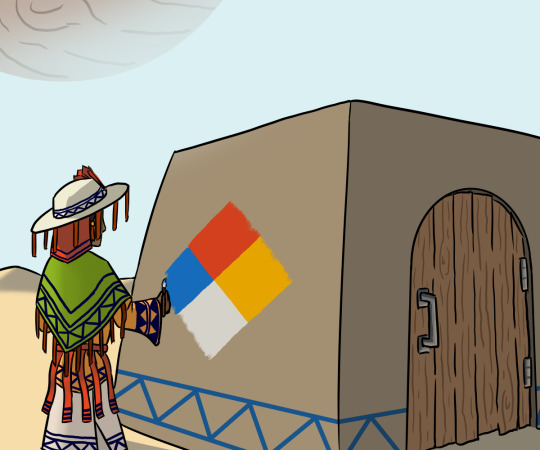
Pictured here is a Larothan priest painting a glyph of protection onto the side of a granary. The people of Laroth believe that such glyphs protect the contents from harm. The blue square is meant to ward of poison, plague and rot; the red square prevents fire- which is deadly in the water-scarce desert; the yellow square defends from the wind, sand and other environmental elements; and finally the white square is meant to hold an additional blessing, decided by a prayer said by the priest while painting it. These additional blessings are often things like protection from war, theft, and other such human-caused problems.
Larothan granaries are small square buildings, usually separate from other buildings, with the grain being kept in a pit inside. Flooding is almost nonexistent in Laroth, and the most common pests can fly, making keeping them suspended mostly unnecessary.
This was inspired by this post from r/worldjerking about the fire diamond being a magic system, and specifically the comment from u/DanDaManatee about a cargo cult.
Eren B is a Mars-sized moon that orbits and is tidally-locked to a Jupiter-sized gas giant. It has been partially terraformed however it still is a pretty hostile environment and has no native life. The people living on Eren B have regressed to a late medieval- renaissance level of technology after the fall of humanity's interstellar empire (the reasons for which I haven't figured out yet)
#worldbuilding#world building#conworld#fantasy#fantasy art#post post apocalypse#post apocalyptic#moving all my stuff over from reddit cause of the api shennanigans#reddit blackout#nuclear spring
3 notes
·
View notes
Text
A Paladin Of The Keepers Of The Peace

The Keepers of the Peace is one of the largest organisations on Eren B. They are a holdover from the time before the Fall, though their exact origins is still under debate. They are a religious military group that is dedicated to preventing unnecessary wars between the many nations of Eren B, though what exactly is considered an "unnecessary" war varies greatly between the many sects. Besides maintaining peace, the Keepers also provide aid during natural disasters- a common occurrence due to Eren B's partial terraforming, uphold the tenants of the Charter- the Keeper's holy book, and protecting the people of Eren B- though once again different sects have very different views on who deserves protection.
Pictured here is a foot soldier of the eastern Larothan sect of the Keepers. He is wearing a blue headwrap, blue headwear being one of the symbols of the Keepers, and headwraps being almost universal among the people of Laroth- the partial terraforming of Eren B left it with a very thin ozone layer, which combined with the desert environment of Laroth makes covering up very important. On top of the headwrap, he's wearing an olive wreath, another symbol of the Keepers, though wearing actual olive leaves is not something every sect does.
He's armed with a spear and shield, with a sword as a sidearm. While firearms have become widespread in other parts of the world, a lack of saltpeter in eastern Laroth means that melee weapons are still standard there.
On his belt are a couple potions, which I will probably retcon, a syringe and a gas bottle. Not sure what to do with those yet.
Eren B is a Mars-sized moon that orbits and is tidally-locked to a Jupiter-sized gas giant. It has been partially terraformed however it still is a pretty hostile environment and has no native life. The people living on Eren B have regressed to a medieval-renaissance level of technology after the fall of humanity's interstellar empire (the reasons for which I haven't figured out yet)
#worldbuilding#world building#writing#conworld#fantasy#fantasy art#paladin#post apocalyptic#post post apocalypse#character concept#yes that is a post-apocalypse UN peacekeeper#moving all my stuff over from Reddit cause of the API shennanigans#reddit blackout#nuclear spring
2 notes
·
View notes
Text
The world of Nuclear Spring
Nobody knows who started the apocalypse. Perhaps the fragile peace between humanity and the various alien races finally fell through. Perhaps it was infighting between the many factions of humanity. Perhaps they merely lost control over an automated weapon system that set the dominoes falling. Regardless of cause, what matters is that the bombs did drop. The many worlds of humanity were blanketed in atomic fire, and the following centuries of nuclear winter killed off most remaining life.
But that was an eon ago. The wounds of the Great War have healed over. The ash clouds have settled, the craters have become lakes. Even the radiation has mostly faded to non-lethal levels. The survivors grouped into bands then tribes and now into full civilizations. The end of the world faded into history, then from history into myth. Now the new civilizations of humanity sprout from the ruins of the old.
And on a far flung colony on a moon once known as Eren B, the reinvention of several key pieces of technology and the rediscovery of incredibly machines from before the Fall have set off a golden age of prosperity and exploration.

Eren B is a large moon about the size of Mars that orbits and is tidally locked to a massive, Jupiter-sized gas giant called Eren. (for those who don't know, being tidally locked means that the same side of the moon always faces the planet, like with our own moon) Because of how large the gas giant is, and how close Eren B orbits it, Eren B goes through a total solar eclipse every day, when it passes behind Eren.
There was no life on Eren B before it was terraformed, and so all the life on it is descended from the few species brought over by the original colonists. This has resulted in an oddly large number of niches being filled by various species of birds.
The civilizations on Eren B are mostly at a late medieval to renaissance level of technology, with a couple notable exceptions- Old Tech being one of them.
The continent in the middle (which I still haven't named yet) is currently the only continent I have fleshed out, which is why the others are drawn with nowhere near as much detail and don't have any seperate biomes.
The red horizontal line denotes the equator. The point where it intersects with the central vertical line is where the gas giant is directly overhead. The other 2 vertical lines are facing towards and away from the direction of the moon's movement.
The main regions I've created so far are as follows:
Laroth, the large central desert is mostly split between the big cities built around oases and the tiny villages and nomadic peoples who survive out in the Sand Sea. They also have a vast supply of Old-Tech because the desert has preserved many ancient structures.
Alorgast, a somewhat mongol-inspired empire in the south. They own almost the entire surviving population of horses on the planet.
Teluo, a lose confederation of city-states in the north-western islands and stretching down the western coast of Laroth. They are very, very loosely inspired by the ancient Greeks.
#world building#worldbuilding#conworld#fantasy world#post post apocalypse#post apocalyptic#fantasy#fiction#fantasy map#nuclear spring
5 notes
·
View notes